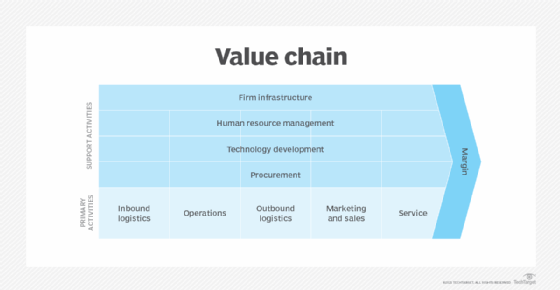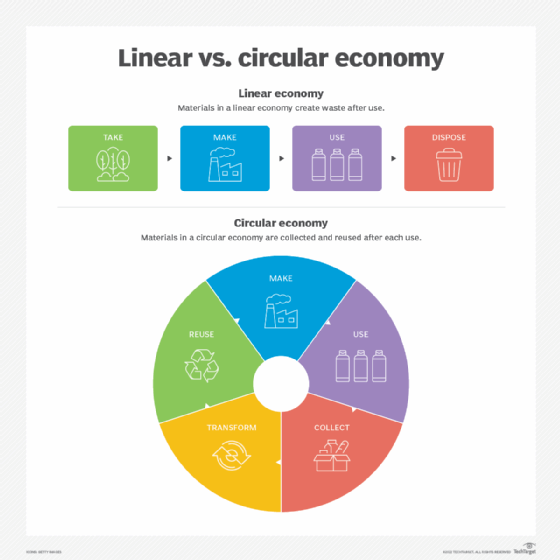value chain
What is a value chain?
A value chain is a concept describing the full chain of a business's activities in creating a product or service -- from initial receipt of materials through its delivery to market.
The value chain framework encompasses five primary activities -- inbound operations, operations, outbound logistics, marketing and sales, and service -- and four secondary activities -- procurement and purchasing, human resource management (HRM), technological development and company infrastructure.
Value chain analysis occurs when a business identifies its primary and secondary activities and evaluates the efficiency of each point. This analysis can reveal linkages, dependencies and other patterns.
The value chain concept emerged in 1985 when Harvard Business School professor Michael Porter described it in his book, Competitive Advantage: Creating and Sustaining Superior Performance.

How do value chains work?
The value chain framework helps organizations identify and group their business functions as primary or secondary activities. Analyzing these value chain activities, subactivities and the relationships between them helps organizations understand them as a system of interrelated functions. Organizations can then individually analyze each to assess whether the output can be improved -- relative to the cost, time and effort required.
Primary value chain activities
Primary activities contribute to a product's or service's physical creation, sale, maintenance and support. These include the following:
- Inbound operations. This is the internal handling and management of resources coming from outside sources, such as external vendors and other supply chain sources. These outside resources flowing in are called inputs and may include raw materials.
- Operations. These are activities and processes that transform inputs into outputs -- the product or service being sold to customers for a higher price than the cost of materials and production, generating a profit.
- Outbound logistics. This is the delivery of outputs to customers. Processes involve systems for storage, collection and distribution to customers. This includes managing a company's internal systems and external systems from customer organizations.
- Marketing and sales. Activities such as advertising and brand building, which seek to increase visibility, reach a targeted audience and communicate why a consumer should purchase a product or service.
- Service. Customer service and product support activities reinforce a long-term relationship with those who have purchased a product or service.
As management issues and inefficiencies are relatively easy to identify here, well-managed primary activities are often the source of a business's cost advantage. This means the business can produce a product or service at a lower cost than its competitors.
Secondary activities
Secondary activities support the primary activities discussed in the previous section and include the following:
- Procurement and purchasing. This involves finding new external vendors, maintaining vendor relationships, and negotiating prices and other activities needed to obtain materials and resources used to build a product or service.
- HRM. The management of human capital includes functions such as hiring, training, building and maintaining an organizational culture, as well as maintaining positive employee relationships.
- Technology development. Activities like research and development, IT management and cybersecurity, as well as anything that builds and maintains an organization's use of technology fall in this category.
- Company infrastructure. This includes legal, general management, administration, accounting, finance, public relations and quality assurance activities.
Benefits of value chains
The value chain framework helps organizations identify sources of their positive or negative cost efficiency. Conducting a value chain analysis can help businesses with the following:
- Support decisions for various business activities.
- Diagnose points of ineffectiveness for corrective action.
- Understand linkages and dependencies between different activities and areas. For example -- issues in HRM and technology are broadly impactful.
- Optimize activities to maximize output and lower costs.
- Establish a cost advantage over competitors.
- Understand core competencies and areas of potential improvement.
While value chain analysis is helpful, when emphasizing granular process details in a value chain, it's important to still give proper attention to an organization's broader strategy.
How to conduct a value chain analysis
Businesses should see the value chain analysis framework as a starting point rather than a complete start-to-finish process. Here are some steps companies can take to understand their value chains:
- Break each primary and secondary activity into subactivities. Analyze each function more granularly to assess its return on investment.
- Look for connections among subactivities. Often, the inefficiency of one activity or subactivity is linked to another. An ill-advised HR hire can create issues that permeate into many areas. Technology and inbound operations can also have ripple effects.
- Diagnose areas of improvement. Consider trends and patterns in the different subactivities and connections between them, and evaluate for potential improvement opportunities in those particular points.
Other value chain considerations
Trends and forces shaping the future of value chains include digital transformation and automation, data security, privacy, customization and personalization. Consider the role of these factors:
- Data security and privacy. As value chains become increasingly digitized, management and protection of vast volumes of data are crucial. This involves compliance with privacy regulations, like the General Data Protection Regulation and the California Consumer Privacy Act; implementing extensive cybersecurity measures; and maintaining ethical standards in data usage. Companies must focus on building customer trust by ensuring transparency and security in their data practices.
- Globalization challenges. The expansion of value chains across multiple countries introduces complexities in coordination, quality control and compliance with international regulations. Companies must navigate cultural differences, manage currency fluctuations, and address environmental and ethical concerns to harness the potential of a global market.
- Collaborative ecosystems. Modern value chains are increasingly part of larger, collaborative ecosystems that include a variety of stakeholders, such as suppliers, distributors, customers and, sometimes, competitors. This collaborative approach fosters shared innovation, enhances flexibility, and emphasizes sustainability and ethical practices, reshaping the structure and management of value chains.
- Impact of the COVID-19 pandemic. The pandemic has highlighted vulnerabilities in global supply chains, leading to a shift away from just-in-time manufacturing and an increased focus on resilience. This has accelerated the adoption of digital technologies and automation and prompted businesses to rethink nearshoring and reshoring strategies to mitigate risks.
- Sustainability and ethical considerations. There is a growing emphasis on sourcing responsibly, creating ethical labor practices, minimizing environmental impact and ensuring transparency in value chains. Sustainable practices and compliance with environmental and labor regulations are becoming integral to maintaining brand reputation and customer trust.
Value chain example: Amazon
For a value chain example, consider some of tech and e-commerce giant Amazon's primary activities.
Inbound logistics
Amazon's primary inputs can be identified as products sold through its own fulfillment services, as well as data center resources that fuel Amazon Web Services (AWS) cloud offerings. Here, Amazon can use its size as a large operation to lower the costs per unit of items it purchases from external suppliers.
Operations
This is where Amazon transforms its inputs into outputs. Amazon's core offering, its online marketplace, offers a secure platform that makes e-commerce easy for both customers and sellers. Because Amazon's fulfillment and logistics can offer two-day shipping to Prime members, the result is a secure, user-friendly customer experience with dramatically lower shipping times than competitors for a similar price point. Amazon's AWS unit transforms inputs into outputs by creating and maintaining cloud servers, storage and other data center resources into a streamlined service for client organizations to host applications and other data.
Outbound logistics
Outbound logistics is key to Amazon's operations, particularly reflecting the growing importance of e-commerce and direct-to-consumer models. This aspect of Amazon's value chain includes several elements:
- E-commerce and direct-to-consumer focus. With the shift toward online shopping, Amazon's fulfillment centers are crucial in enabling quick, direct-to-consumer delivery.
- Advanced fulfillment centers. Amazon operates numerous fulfillment centers globally, using advanced robotics and automation technology to enhance warehouse efficiency and reduce delivery times.
- Two-day and same-day shipping. Amazon's commitment to fast shipping, including two-day and, in some areas, same-day delivery for Prime members, sets a high standard in e-commerce logistics.
- Digital delivery expansion. Amazon has expanded its digital delivery offerings, including streaming services, e-books and cloud services through AWS. This expansion represents a shift toward digital products and services, aligning with the increasing consumption of digital content.
- Integration of physical and digital retail. Amazon's acquisition of Whole Foods and the establishment of Amazon Go stores showcase an innovative blend of physical and digital retail experiences. These brick-and-mortar locations serve as retail spaces and facilitate online order pickups and returns, enhancing customer convenience.
- Diversification with cosourcing and outsourcing. To manage the vast scale of its operations, Amazon continues to use cosourcing and outsourcing strategies. This includes partnerships with third-party logistics providers to handle excess demand and specialized delivery services, ensuring scalability and flexibility in its logistics network.
- Customer-centric returns and services. Amazon has streamlined its return process, offering easy return options at Whole Foods, Kohl's and other locations. This enhances the overall consumer experience, encouraging repeat business and loyalty.
By constantly evolving its outbound logistics to align with the rapid growth of e-commerce and changing consumer demands, Amazon maintains its position as a leader in online retail and sets trends for the future of digital shopping and direct-to-consumer delivery models.
Marketing and sales
According to Statista, Amazon spent $13.5 billion on marketing and advertising in 2022, seeking to maintain its role as one of the world's most recognizable brands.
Future trends in value chains
Looking ahead, several emerging trends are poised to further transform value chains. These reflect technological advancements and a shift in global business practices and consumer expectations:
- Blockchain for enhanced transparency. Blockchain technology is increasingly being adopted for its ability to offer unparalleled transparency and security in supply chains.
- The rise of circular economy models. The concept of a circular economy, focused on sustainability and minimizing waste, is gaining traction. This model emphasizes the reuse and recycling of materials and products, encouraging businesses to design products with their lifecycle in mind.
![A chart contrasting the linear economy with the circular economy]()
By recycling devices, organizations can contribute to the circular economy -- cutting down on the amount of waste they create and raw materials they consume. - Impact of 5G technology. The rollout of 5G technology is expected to dramatically impact value chains, particularly in areas like internet of things, automation and real-time data processing.
- Artificial intelligence (AI) and machine learning for predictive analytics. The use of AI and machine learning in value chains will grow, particularly in predictive analytics. These technologies can forecast market trends, consumer behavior and potential supply chain disruptions, enabling businesses to be proactive.
- Customization at scale. Advances in technology are making it increasingly feasible to offer personalized products and services at scale. This trend is likely to continue, with businesses using data analytics, AI and flexible manufacturing processes to meet individual customer preferences without sacrificing efficiency.
- Integration of digital and physical experiences. The blending of digital and physical experiences is expected to continue with businesses seeking to provide a seamless customer journey. This includes the integration of online and offline channels, enhancing customer engagement and providing a unified brand experience.
- Increased focus on ethical and social responsibility. Consumers and regulators are placing greater emphasis on ethical practices and social responsibility. Businesses need to pay more attention to fair labor practices, ethical sourcing and community impact.
As these trends gain traction, they create new opportunities and challenges for businesses. Staying ahead in this dynamic landscape requires continuous innovation, adaptability, and a commitment to embracing new technologies and sustainable practices.
Being aware of the advantages and disadvantages of value chain analysis is important when an organization is looking to optimize efficiency and reduce costs. Explore advantages and disadvantages of value chain analysis.







